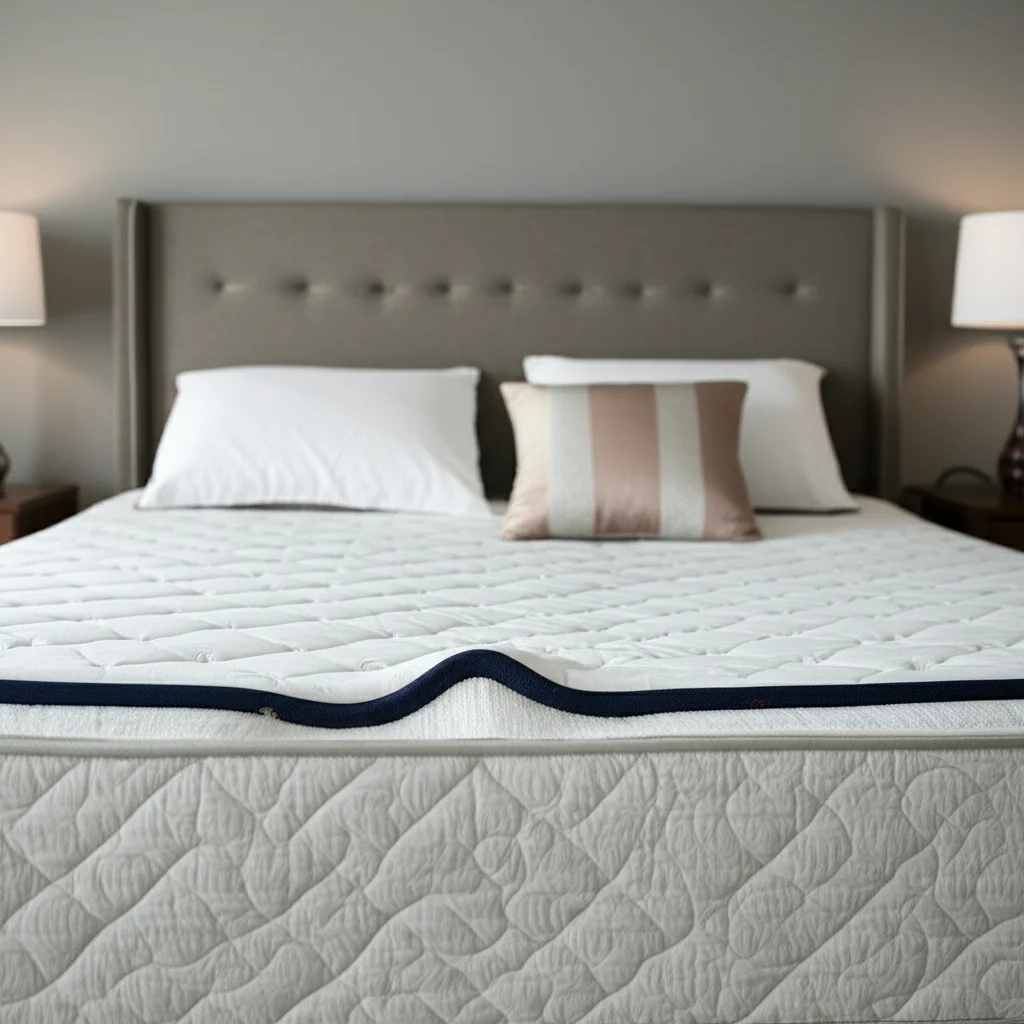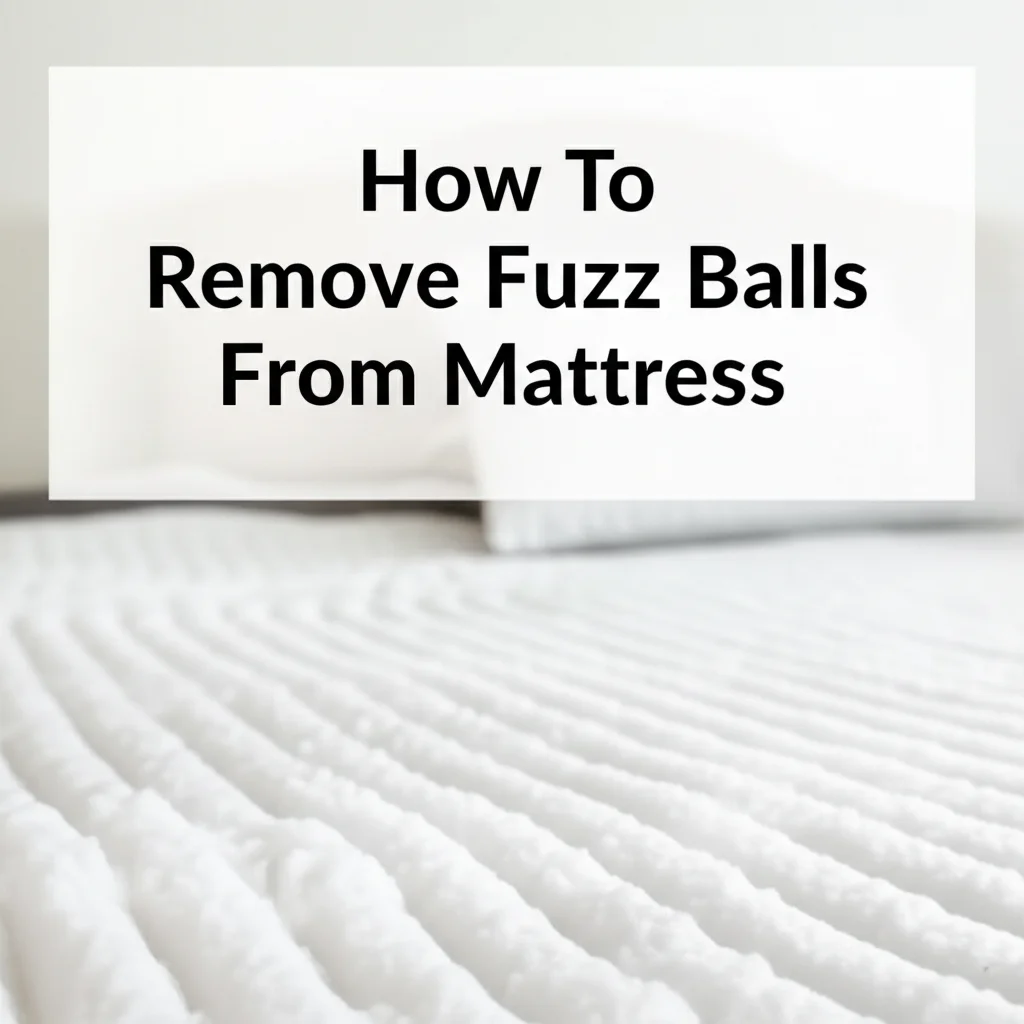· Todd Martin · Mattress Care · 20 min read
How To Fix Divot In Mattress

Revive Your Sleep: How to Fix a Divot in Your Mattress
Do you wake up feeling tired, perhaps with back pain? A common culprit for poor sleep is a divot in your mattress. These indentations, sometimes called sags or depressions, can make your bed uncomfortable. They prevent your body from getting proper support during the night.
It feels frustrating when your once-comfortable bed develops a deep impression. A mattress divot affects sleep quality and overall well-being. Many people face this issue but do not know where to start fixing it. Luckily, several effective methods exist to address these dips and restore comfort to your sleep surface. This guide will walk you through understanding, assessing, and fixing mattress divots. You will learn various techniques, from simple adjustments to more involved DIY repairs.
Takeaway
- Assess the Divot: Determine the depth, location, and mattress type to choose the best repair method.
- Rotate or Flip: Regularly rotating or flipping your mattress helps distribute wear and prevent new divots.
- Add Support: Use mattress toppers, plywood, or foam inserts to fill existing divots and add support.
- Check Foundation: Ensure your bed frame and foundation provide adequate and even support.
- Consider Replacement: For severe or old divots, replacing the mattress might be the most effective long-term solution.
Concise Answer to Fixing a Mattress Divot
To fix a divot in your mattress, first assess its depth and your mattress type. Simple solutions include rotating or flipping the mattress. For deeper divots, add extra support using a mattress topper, strategically placed pillows or blankets, or a plywood board underneath. Ensure your bed frame and foundation provide adequate, even support to prevent future depressions.
Understanding Mattress Divots: Causes and Impact
A mattress divot is an indentation or depression that forms on the surface of your bed. These dips often match where a person regularly sleeps. Over time, the materials inside the mattress begin to compress and wear down. This leads to a loss of support in specific areas. Understanding why these divots form is the first step in addressing them effectively.
Several factors contribute to the formation of mattress divots. The most common cause is the consistent application of body weight in the same spot. This constant pressure breaks down the internal structure of the mattress. Another major factor is the age of the mattress. As mattresses get older, their materials naturally degrade. Springs can lose their coil tension, and foam layers can lose their elasticity.
Poor quality materials also play a significant role. Cheaper mattresses might use less dense foam or lower gauge springs. These materials are more prone to breaking down quickly. An inadequate or damaged bed foundation can also cause divots. A weak box spring or broken bed slats cannot properly support the mattress. This leads to uneven weight distribution and premature sagging. For instance, if you have bed slats that keep falling, your mattress support is compromised. Similarly, a broken wooden bed frame can lead to divots.
The impact of mattress divots extends beyond just aesthetics. They significantly affect your sleep quality and physical health. A divot prevents your spine from maintaining its natural alignment. This misalignment can cause back pain, neck pain, and joint stiffness. You might find yourself tossing and turning more, struggling to find a comfortable position. This leads to interrupted sleep and fatigue during the day. Addressing a mattress divot is crucial for maintaining a healthy sleep environment and ensuring restful nights.
Assessing Your Mattress Divot: Is It Fixable?
Before you attempt to fix a mattress divot, you must assess its severity and type. Not all divots are created equal. Some are minor and easy to remedy, while others indicate a mattress beyond repair. This assessment helps you choose the most effective solution. It also saves you from wasting time on methods that will not work.
Start by visually inspecting your mattress. Look for any noticeable dips or depressions where you typically sleep. Use a long, straight object, like a yardstick or broom handle, to lay across the mattress surface. This helps you clearly see the extent of the divot. Measure the depth of the deepest part of the divot from the straight edge. A divot deeper than 1.5 inches, or sometimes even 1 inch depending on mattress warranty, often points to significant structural damage.
Next, consider the age of your mattress. Most mattresses have a lifespan of 7 to 10 years. If your mattress is older than this, a divot likely means the materials are fully worn out. Fixing it might only provide temporary relief. Understanding the type of mattress you own is also important. Memory foam mattresses can develop body impressions that feel like divots. These are often normal and can sometimes be improved with heat or rotation. Innerspring mattresses, however, might have issues with springs collapsing. Hybrid mattresses combine foam and springs, meaning they can have issues from either component.
The presence of lumps, bumps, or strange noises also provides clues. If you feel coils poking through, or hear squeaking sounds, the internal structure is breaking down. These are signs of a more severe problem. A small, shallow divot in a newer mattress might be fixable with simple adjustments. A deep divot in an old mattress suggests it is time for a replacement. Always check your mattress warranty, as some cover divots over a certain depth.
Immediate Mattress Divot Solutions
When you discover a divot in your mattress, some immediate, simple solutions can provide temporary relief. These methods do not fix the underlying structural issue but can improve comfort. They can extend the usable life of your mattress for a short period. These quick fixes are great if you are waiting for a new mattress or saving up for one.
The easiest and most common solution is to rotate or flip your mattress. Not all mattresses are designed for flipping. Many modern mattresses are one-sided, meaning they have a specific top layer. Check your mattress’s care instructions first. If you have a two-sided mattress, flipping it allows the worn-out side to recover. It distributes wear evenly on the other side. If your mattress is one-sided, rotating it 180 degrees can help. This moves the area where your body impressions form to a different spot. This simple act can redistribute pressure and make the bed feel more even. I try to rotate my mattress every three to six months.
Adding a mattress topper is another effective immediate solution. A good quality mattress topper can add an extra layer of comfort and support. It fills in the divot and creates a more level sleeping surface. Toppers come in various materials, such as memory foam, latex, or down. Choose a topper that matches your desired firmness and support needs. A thick memory foam topper, for example, can mold to your body. It provides cushioning over the existing divot. While it does not fix the original mattress, it makes it much more comfortable to sleep on.
For very localized divots, you can use extra padding. Try placing a folded blanket, a thin pillow, or even a small piece of foam under the mattress sheet, directly within the divot area. This builds up the depressed spot. It makes the surface feel more even beneath you. This method is highly temporary and might shift during the night. However, it can offer a quick fix for a night or two. These immediate solutions buy you time and improve your sleep quality while you consider more permanent repairs or replacement.
Reinforcing Mattress Support for Deeper Divots
For divots that persist despite rotation or toppers, reinforcing the mattress support system is often necessary. These methods address the underlying issue of insufficient support. They can significantly improve the longevity and comfort of your existing mattress. This approach is more involved than simple rotations but offers more substantial results.
One highly effective method is adding a piece of plywood under the mattress. A thin sheet of plywood, typically 1/2 to 3/4 inch thick, placed between the mattress and its foundation, can provide a solid, even surface. This helps distribute your weight more uniformly across the mattress. It prevents further sagging and lifts the divoted area. You can cut the plywood to the exact dimensions of your bed frame or purchase pre-cut sheets. For a queen or king bed, use two smaller pieces of plywood side-by-side to make it easier to handle. This solution is particularly useful for innerspring mattresses where coils may have weakened. It is also beneficial for foam mattresses that need more rigid support. You can learn more about how to fix a sagging mattress with plywood.
Another approach involves checking and reinforcing your bed’s foundation. A weak or broken box spring, or inadequate bed slats, contributes directly to mattress divots. Inspect your box spring for any visible damage, sagging, or broken springs. If you have a slatted bed frame, ensure the slats are evenly spaced, not broken, and provide sufficient support. For slatted frames, adding more slats or strengthening existing ones can make a big difference. You can purchase additional slats or reinforce them with crossbeams. Ensure the center support legs of your bed frame are also intact and not bent. A sagging foundation directly translates to a sagging mattress.
If you have a foam mattress, strategically placed foam inserts can help. For divots in foam or memory foam mattresses, you can try to cut a piece of high-density foam to fit the shape of the divot. Place this foam piece under the mattress cover but above the internal layers. This provides targeted support. It fills the depression from within. This method requires a bit more precision. You must access the internal layers of your mattress. However, it can be very effective for specific foam-based divots. These reinforcement methods address the root cause of divots. They restore proper support to your mattress.
DIY Techniques for Specific Mattress Types
The best way to fix a divot often depends on the type of mattress you own. Different materials respond to different repair techniques. Understanding your mattress’s construction helps you choose the most effective DIY approach. I find that tailoring the fix to the mattress type gives the best results.
Memory Foam and All-Foam Mattresses
Memory foam and all-foam mattresses form body impressions over time. These impressions can feel like divots. They usually result from the foam softening and conforming to your shape. To address these, you can try a few things. First, rotate your mattress regularly, as memory foam mattresses are typically one-sided. This helps distribute wear to different areas. Second, heat can sometimes help memory foam regain its shape. You can try gently heating the divoted area with a hairdryer on a low setting, moving it constantly to prevent scorching. While applying heat, gently press and fluff the foam to help it expand.
For a deeper divot in a memory foam mattress, consider adding high-density foam layers. You can carefully unzipper the mattress cover if possible. Then, insert a piece of firm foam directly into the divoted area. This piece should be cut to match the size and depth of the sag. It acts as a filler and provides additional support. Always ensure the new foam is breathable to avoid heat buildup. Cleaning memory foam is a specific process; if you decide to open the mattress, remember how to clean memory foam mattress should be part of your overall care.
Innerspring and Hybrid Mattresses
Innerspring mattresses rely on a coil system for support. Divots in these mattresses often mean that some coils have weakened or compressed. Hybrid mattresses combine coils with foam layers. So, they can suffer from both coil and foam issues. For these types, addressing the internal support is key.
You can try to reinforce the coil system. If you can access the coils (often by opening the mattress cover), you might be able to add padding directly over the weakened coils. Use firm foam or dense batting to fill the gaps and provide extra cushioning. This helps to level the surface. However, this is a more advanced DIY task and might void your warranty. Alternatively, adding a plywood board between the mattress and the box spring is highly effective for innerspring and hybrid mattresses. This provides a solid, uniform base that supports the entire coil system. It prevents further sagging and helps to lift the divoted area. This method is less invasive and generally safer for your mattress.
Remember, the goal of these DIY fixes is to improve comfort and extend the life of your mattress. They might not completely restore your mattress to its original state. However, they can significantly enhance your sleep experience.
Optimizing Your Sleep Environment to Prevent Divots
Preventing mattress divots is often easier and more cost-effective than fixing them. By making a few simple adjustments to your sleep environment and mattress care routine, you can significantly prolong your mattress’s life. These proactive steps ensure your bed provides consistent support for years to come.
Regular mattress rotation is one of the most important preventative measures. For most mattresses, rotating it 180 degrees every three to six months helps distribute wear evenly. This means the areas that bear the most weight, like your torso, move to different parts of the mattress. This reduces concentrated pressure points. If your mattress is flippable (designed to be slept on both sides), make sure to flip it every six months. This allows both sides to recover and wear down uniformly. Always check your manufacturer’s recommendations for rotation and flipping guidelines.
Ensuring you have a proper and supportive foundation is crucial. Your mattress relies on its foundation for overall stability and support. A weak or damaged box spring, a sagging platform bed, or insufficient slats can all lead to divots. Regularly inspect your bed frame and foundation for signs of wear. Check for broken slats, bent metal frames, or sagging areas in your box spring. If you have a slatted bed, ensure the slats are no more than 2-3 inches apart. This provides continuous support. Adding extra slats or a solid bunkie board can enhance support. This prevents your mattress from sinking between gaps.
Using a good quality mattress protector can also help. While a protector primarily guards against spills and allergens, it adds a thin layer of cushioning. This layer can provide minor additional support. It helps prevent direct impact wear on the mattress surface. A protector cannot prevent major structural divots. However, it contributes to the overall preservation of your mattress. Putting on a mattress protector is a simple step with long-term benefits. Proper maintenance and a supportive foundation are your best defense against mattress divots.
When to Consider Replacing Your Mattress
Despite your best efforts to fix a divot, there comes a time when replacement is the only viable option. Knowing when to stop patching and start shopping can save you from continued discomfort and wasted effort. Your mattress has a lifespan, and recognizing its end is key to healthy sleep.
A primary indicator that it’s time for a new mattress is its age. Most mattresses are designed to last between 7 and 10 years. After this period, the internal components, whether coils or foam, degrade beyond repair. Even with diligent rotation and maintenance, materials simply wear out. If your mattress is approaching or has exceeded this age, a divot is often a sign of widespread material breakdown. Trying to fix it will likely be a temporary measure.
The depth and persistence of the divot also tell you when to replace. If a divot is consistently deeper than 1 to 1.5 inches, even after rotating or adding extra support, the mattress has lost its structural integrity. This deep sag means your spine cannot be properly aligned. No amount of plywood or toppers will truly fix a severely broken-down core. You might also notice multiple divots or widespread sagging across the entire mattress. This indicates a general failure of the support system.
Your sleep quality and physical well-being are the ultimate guides. If you consistently wake up with back pain, neck stiffness, or numbness, your mattress is no longer providing adequate support. If you find yourself sleeping better on other beds (like at a hotel or a friend’s house) than on your own, it’s a strong sign. A mattress should help you feel refreshed. If it contributes to pain or fatigue, it is not serving its purpose. Investing in a new mattress is an investment in your health and well-being. Do not hesitate to replace it if it is truly past its prime. Sometimes, a full deep clean of your mattress can reveal other issues, but typically a persistent divot means it is time for a new one.
Troubleshooting Common Mattress Divot Issues
Even with the best intentions, fixing a mattress divot can present challenges. Sometimes the initial fix does not work as expected. Other times, new issues appear. Understanding common troubleshooting steps helps you refine your approach. It ensures you get the most out of your repair efforts.
One common problem is that the divot reappears shortly after a fix. This often happens if the underlying cause was not fully addressed. For instance, if you only rotated the mattress but the foundation was weak, the divot will return. In this case, re-evaluate your bed frame and box spring. Ensure they offer robust, even support. Consider adding a plywood board or extra slats if you haven’t already. Sometimes, a temporary fix like a topper works for a while, but the underlying mattress continues to degrade. This signals it might be time to move towards replacement, or a more permanent solution like a foundation reinforcement.
Another issue is when a mattress topper or pad slides around, failing to stay over the divot. This can be frustrating, especially if you are relying on the topper for comfort. Ensure your mattress topper has anti-slip features on its bottom surface. You can also use mattress straps or suspenders to secure the topper to the mattress. Placing a non-slip rug pad between the mattress and topper can also create friction. This prevents movement. For those using a mattress pad, understanding how to keep your mattress pad from sliding can make a big difference.
Sometimes, attempting to fix a divot reveals other problems, like squeaking. A newly introduced squeak might indicate that your bed frame or box spring components are now under different stress. Tighten all bolts and screws on your bed frame. Check if the box spring slats are rubbing against the frame. Lubricating joints with WD-40 or silicone spray can also quiet squeaks. Ensure the issue isn’t related to the mattress itself, but rather the support system. Addressing these secondary issues helps ensure your entire sleep setup provides optimal comfort and quiet.
Maintaining Your Mattress for Long-Term Comfort
Beyond fixing existing divots, ongoing maintenance is vital for extending the life of your mattress. A proactive approach to mattress care helps prevent new divots from forming. It also ensures your mattress remains comfortable and supportive for as long as possible. Integrating simple habits into your routine can make a significant difference.
Regular rotation or flipping is paramount. I recommend rotating your mattress 180 degrees every three to six months. If your mattress is designed to be flipped, do so twice a year. This distributes body weight and wear more evenly across the entire surface. It prevents specific spots from breaking down quickly. Consistent rotation helps maintain the mattress’s structural integrity. It keeps the comfort layers from developing permanent impressions.
Protecting your mattress from spills and dust is also important. Use a high-quality mattress protector from day one. This barrier prevents moisture, sweat, and allergens from penetrating the mattress materials. Moisture and dirt can degrade mattress components over time. A protector keeps the mattress clean and hygienic. It also adds a thin layer of protection against minor wear. When it needs cleaning, remember that knowing how to clean a mattress protector helps keep your entire sleep system fresh.
Beyond spills, regularly vacuum your mattress. This removes dust mites, dead skin cells, and other debris that can accumulate. A clean mattress is a healthy mattress. Airing out your mattress periodically helps too. Remove all bedding and let the mattress breathe for a few hours. This helps dissipate moisture and odors. Some people like to open windows during this process for better air circulation. By taking these simple maintenance steps, you can significantly extend the lifespan of your mattress. You will reduce the likelihood of severe divots. This ensures you enjoy comfortable and supportive sleep for many years.
FAQ Section
Q1: Can a mattress divot be truly fixed permanently?
A mattress divot can often be improved, but a true permanent fix depends on the severity. For minor divots in newer mattresses, rotation, toppers, or plywood can offer significant long-term relief. For deep divots in old mattresses, these solutions are usually temporary. The mattress might have reached the end of its usable life.
Q2: How deep does a mattress divot need to be before I should worry?
You should start worrying about a mattress divot when it is deeper than 1 to 1.5 inches. This depth often indicates significant material breakdown. Such a divot can affect spinal alignment and lead to discomfort. Many mattress warranties also define a sag of this depth as a defect.
Q3: Will a mattress topper completely hide a divot?
A mattress topper can effectively hide and mitigate the feeling of a divot. It provides an extra layer of cushioning and support, creating a more even sleep surface. However, it does not fix the underlying structural issue of the mattress. The divot is still there; the topper just makes it less noticeable and more comfortable.
Q4: How often should I rotate my mattress to prevent divots?
You should rotate your mattress 180 degrees every three to six months. This regular rotation helps distribute body weight and wear evenly across the mattress surface. For mattresses that are flippable, you should flip them every six months as well. This prevents concentrated pressure points that lead to divots.
Q5: Can a bad bed frame cause mattress divots?
Yes, a bad bed frame or inadequate foundation is a common cause of mattress divots. If the bed frame’s slats are too far apart, broken, or if the box spring is sagging, it won’t properly support the mattress. This leads to uneven pressure distribution and premature divot formation in the mattress itself.
Q6: When is it definitely time to replace my mattress due to a divot?
It is definitely time to replace your mattress if the divot is very deep (over 1.5 inches), the mattress is older than 7-10 years, or you consistently wake up with pain or discomfort, even after trying various fixes. These signs indicate the mattress has lost its structural integrity and cannot provide proper support anymore.
Conclusion
Finding a divot in your mattress can be disheartening. It often signals the end of comfortable, restorative sleep. However, before you rush to buy a new bed, remember that many mattress divots are fixable. You have several effective strategies at your disposal. From simple acts like rotating your mattress to more involved DIY solutions like adding plywood, there are ways to restore comfort. I believe in trying these methods first.
The key to successfully learning how to fix a divot in mattress lies in understanding its cause and the type of mattress you own. Immediate solutions like mattress toppers offer quick relief. Reinforcing your bed’s foundation provides a more lasting improvement. Most importantly, regular maintenance through consistent rotation and using a mattress protector will help prevent future divots. Ultimately, if your mattress is old and severely worn, replacement is the best investment in your sleep health. Take action today to restore comfort to your bed and ensure you wake up refreshed and pain-free. Sweet dreams are within reach!





